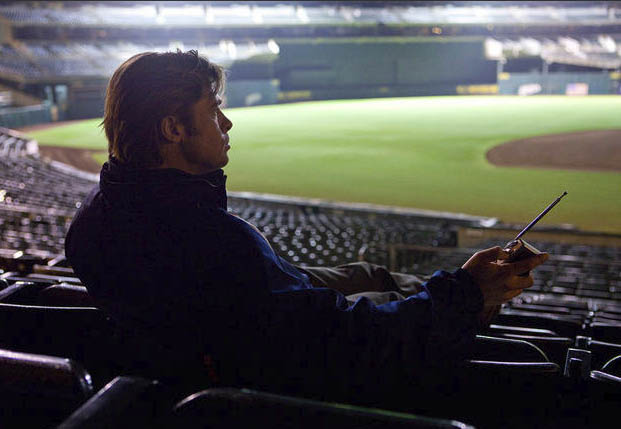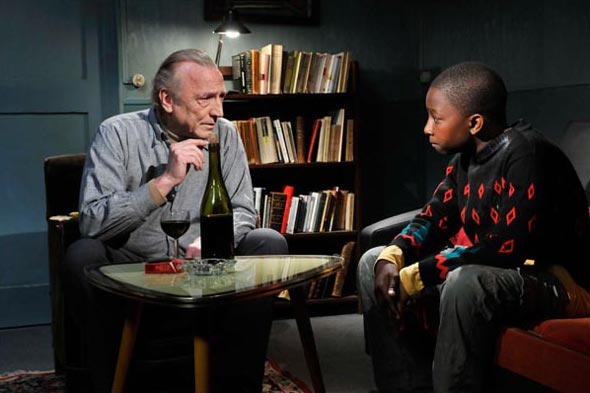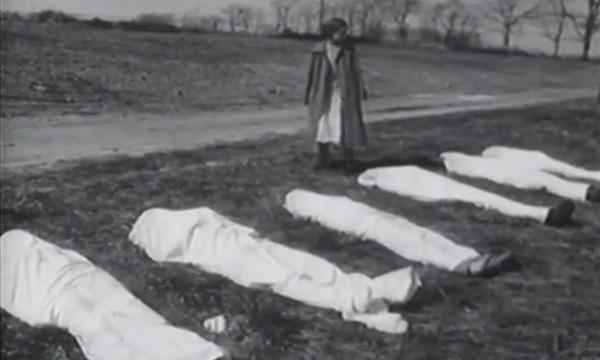This is the first of two Moneyball reviews we’ve published. The second, which gets into the baseball nitty-gritty, can be read here.
— Now up to bat. Kenneth Turan, suckered in by the story, believing that the Mickey Mantle epigraph celebrates profuuuuuuuuuuuuuundity but really is more of a marketing gimmick that fools you into believing that It is Important.
— Well, Jack, I’m not sure you’re being fair towards Turan. Every time he gets on the plate, his eyes just widen at middlebrow pitches.
— But, Phil, did you see the way Turan immediately fell for the hook about this being “a famously troubled production.” And that crack about Pitt “who must have had a sense of how good a role this was for him.” Did he just cut and paste the press notes?
— I wouldn’t know, Jack. The movie started late and Sony was confiscating everybody’s cell phones as if they were criminal thugs.
— Sounds like you’re a bit bitter.
— Well, yeah. But I had also seen a rather amazing film that day called Le Havre. And, well, Moneyball paled by comparison. Have you seen it, Jack?
— No, Phil. I don’t do subtitles.
— Your loss, Jack.
— You know, now that you mention it, I’m not sure how much Philip Seymour Hoffman’s Oscar win for Capote has to do with his role in the movie.
— “Letter-perfect,” Turan wrote before the last pitch.
— Looks like the copyediting umpire is throwing signals.
— I still don’t think Turan stands for anything.
— You’re right about that. Four balls, two strikes. Looks like they’re going to walk Turan. And there he is! Throwing the bat, doing his little strut.
— Is he actually trying to job?
— I guess so. He’s got a jolly little roll in his belly. It looks like he’s been eating hot meals, Phil.
— Middlebrow critics often do. Now heading for the plate: Manohla Dargis, whipping out that Tennyson in the lede.
— You know, that’s a very impressive move.
— Baseball is poetry!
— But a hungry heart? And why the hyperlink? Didn’t the New York Times figger its readers would recognize “Ulysses” by the two words alone?
— They probably think sports fans are dumb or something.
— “Liquid physical grace and bright eyes of a predator.” That’s some serious description, but is it poetry?
— You can’t talk about Brad Pitt without considering how he looks soooooooooooooo much like Redford.
— You mean they’re grooming him to take over when Redford croaks?
— Could be.
— Who’s on Sundance?
— What’s at Telluride?
— I don’t know is at Toronto.
— That’s right. You know, like Turan, she’s really paying attention to the titles that are flashing on the screen.
— You mean the numbers?
— I mean the numbers. Did you really think this movie was exuberant?
— Well, after a while, I got bored.
— Why’s that?
— It seems condescending to reduce the complexities of baseball down to two distinct visions.
— Strike for Dargis.
— Yeah, she’s not hitting well this season.
— Cut her some slack. There’s the New York Film Festival too.
— Sure. But two distinct visions. Here’s a movie that suggests it’s either all about hard statistics or all about the love of the game. And, really, was the Michael Lewis book that cut and dry?
— No. Strike!
— Well with Turan on first and the home team down a few runs…
— Can I just stay that I love the way Manohla goes to the trouble of saying that Billy has a great face. After that whole business of “liquid physical grace.”
— Do you think she wants to fuck Brad Pitt?
— Hey, who doesn’t? But does Brad Pitt’s handsomeness have anything to do with the movie?
— Not really.
— Can they really put it up there with The Social Network?
— Same producer. Sorkin wrote some of it.
— You see, that’s just it. The script seems to be a bastard hybrid of Steven Zallian’s heartfelt stuff.
— Brad Pitt’s kid? That song she sings?
— That silly song she sings. And Sorkin’s robust moralizing. It just doesn’t feel right. It should have been either one or the other.
— Oh, come on, have some sympathy for the Hollywood machine.
— It’s difficult. I can’t. These movies can be so much smarter.
— Dargis swings. And…….misses.
— First out for the home team.
— And to think that Sony handpicked the right critics for this. Do you think this stands a chance of winning Best Picture?
— One word. Crash.
— And who doesn’t like baseball?
— There’s that book from Chad Harbach.
— You’re not one of those readers, are you?
— No. Not really.
— Good. We’re supposed to keep the skepticism at a minimum.
— Why is that?
— Well, it’s good form! Because they might not invite us to additional screenings.
— One more thing about Manohla. I loved the way she tried to read significance in the American flags, trying to find a symbol.
— They are a symbol. We do that for every game.
— No, a September 11th symbol. Isn’t that a bit reaching?
— Well, what do you expect from Manohla? Now batting: Richard Corliss!
— He’s swinging wild.
— Well, he’s dealing with a funny pitcher.
— Not funny. Statistically proven to gain the approval of critics too calcified to rock the boat.
— I love how Corliss praised “the star’s administrative strategies.”
— It’s a paean to Big Business!
— “A solid, bustling social comedy at the 130-IQ level?” Were you laughing much?
— No. I mean, I liked Jonah Hill.
— He’s funny.
— Jonah Hill is funny. But in this he’s actually quite good in a dramatic role.
— So does the presence of Jonah Hill turn this into a “bustling social comedy?”
— Not really.
— You gotta give Corliss this. Love the way he commends Bennett Miller for including scenes of Billy driving at night.
— Cutaways.
— Smashing things up.
— A lot of movies have that.
— Working out in the team gym.
— Come on, when you’ve got Pitt’s muscles?
— But do you think he’s overpraising the movie for these shots? I mean, there was a time when all movies had these shots.
— Maybe that’s why he’s so excited.
— 130-IQ level? What does he mean by that?
— It means this film is just short of genius.
— Is Bull Durham or Major League at the 130-IQ level?
— They don’t have number crunching.
— But you’re still rooting for the success of the team? I mean, by Corliss’s standards…
— The Bad News Bears is at the 130-IQ level.
— The original or the Linklater remake?
— Let’s not talk about the remake.
— “The central pairing, though, has championship stuff.”
— How so?
— Because it gives Corliss an excuse to make another Social Network comparison.
— Beane and Brand are the Winklevoss twins?
— Hey, if you stare really hard, Brad Pitt and Jonah Hill are kinda identical.
— Do you think “a walk is as good as a hit” is debatable?
— I don’t know. We just announce it.
— He’s out!
— What’s Corliss’s batting average these days?
— Don’t ask.
— Do we have a team?
— We do. And they’ll do anything the manager says.




